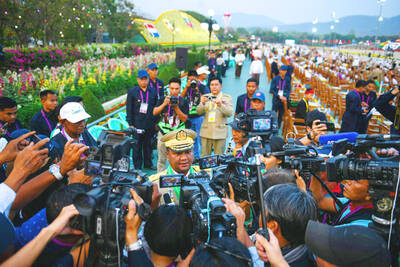China could meet all of its future electricity needs with wind power if the government continues to subsidize the development of wind farms with price guarantees, a study published on Thursday said.
Already the world’s largest emitter of carbon dioxide, China’s electricity needs are expected to double in the next two decades and it is currently adding several new coal-fired power plants to its grid every week.
“The real question for the globe is: What alternatives does China have?” said lead author Michael McElroy of Harvard’s School of Engineering and Applied Sciences.
McElroy’s team used meteorological and geographical data to calculate China’s total wind capacity and then estimated how much power could be delivered profitably at different floor prices.
They found that wind energy providers could profitably supply all of China’s projected electricity demand by 2030 if they receive at least 0.516 yuan (US$0.076) per kilowatt hour for the first 10 years.
That’s in line with the price guarantees China has awarded in recent concessions to wind farm operators which ranged from 0.382 to 0.551 yuan per kilowatt hour.
“This suggests that it would be possible to eliminate much if not all of the carbon dioxide expected to be emitted by the power sector over the foreseeable future,” the study published in the journal Science concluded.
A contract price as low as 0.4 yuan per year would be sufficient to displace 23 percent of energy generated by coal, the study said.
“This would require a major investment of resources and could be accomplished only on the basis of a carefully designed long-range plan for the Chinese power sector,” the authors wrote.
“Benefits in terms of improvements in Chinese air quality would be substantial, however, and there could be important benefits also for the Chinese economy,” they said.
By contrast, meeting future needs with coal could increase carbon emissions by 3.5 gigatonnes a year from the current annual level of 6.6 gigatonnes. Health problems caused by air pollution are estimated to cost 0.7 percent to 4.3 percent of China’s GDP, the authors said.
And while they estimate it would cost about 6 trillion yuan (US$900 billion) to introduce 640 gigawatts of wind power over the next 20 years, they said it is just a fraction of China’s current annual GDP of about 26 trillion yuan and major investments in generating capacity must be made regardless.
China’s future energy needs could also be met without radically altering its landscape or displacing farmers, the authors said.
A network of wind turbines operating at as little as 20 percent of their capacity would be able to produce as much as 24.7 petawatt hours of electricity annually, which is seven times the country’s current consumption.
“Wind farms would only need to take up land areas of 0.5 million square kilometers, or regions about three quarters of the size of Texas,” said co-author Xi Lu, a graduate student in McElroy’s group at Harvard. “The physical footprints of wind turbines would be even smaller, allowing the areas to remain agricultural.”

Eleven people, including a former minister, were arrested in Serbia on Friday over a train station disaster in which 16 people died. The concrete canopy of the newly renovated station in the northern city of Novi Sad collapsed on Nov. 1, 2024 in a disaster widely blamed on corruption and poor oversight. It sparked a wave of student-led protests and led to the resignation of then-Serbian prime minister Milos Vucevic and the fall of his government. The public prosecutor’s office in Novi Sad opened an investigation into the accident and deaths. In February, the public prosecutor’s office for organized crime opened another probe into

RISING RACISM: A Japanese group called on China to assure safety in the country, while the Chinese embassy in Tokyo urged action against a ‘surge in xenophobia’ A Japanese woman living in China was attacked and injured by a man in a subway station in Suzhou, China, Japanese media said, hours after two Chinese men were seriously injured in violence in Tokyo. The attacks on Thursday raised concern about xenophobic sentiment in China and Japan that have been blamed for assaults in both countries. It was the third attack involving Japanese living in China since last year. In the two previous cases in China, Chinese authorities have insisted they were isolated incidents. Japanese broadcaster NHK did not identify the woman injured in Suzhou by name, but, citing the Japanese

RESTRUCTURE: Myanmar’s military has ended emergency rule and announced plans for elections in December, but critics said the move aims to entrench junta control Myanmar’s military government announced on Thursday that it was ending the state of emergency declared after it seized power in 2021 and would restructure administrative bodies to prepare for the new election at the end of the year. However, the polls planned for an unspecified date in December face serious obstacles, including a civil war raging over most of the country and pledges by opponents of the military rule to derail the election because they believe it can be neither free nor fair. Under the restructuring, Myanmar’s junta chief Min Aung Hlaing is giving up two posts, but would stay at the

YELLOW SHIRTS: Many protesters were associated with pro-royalist groups that had previously supported the ouster of Paetongtarn’s father, Thaksin, in 2006 Protesters rallied on Saturday in the Thai capital to demand the resignation of court-suspended Thai Prime Minister Paetongtarn Shinawatra and in support of the armed forces following a violent border dispute with Cambodia that killed more than three dozen people and displaced more than 260,000. Gathered at Bangkok’s Victory Monument despite soaring temperatures, many sang patriotic songs and listened to speeches denouncing Paetongtarn and her father, former Thai prime minister Thaksin Shinawatra, and voiced their backing of the country’s army, which has always retained substantial power in the Southeast Asian country. Police said there were about 2,000 protesters by mid-afternoon, although